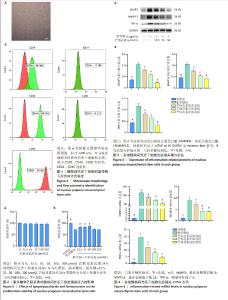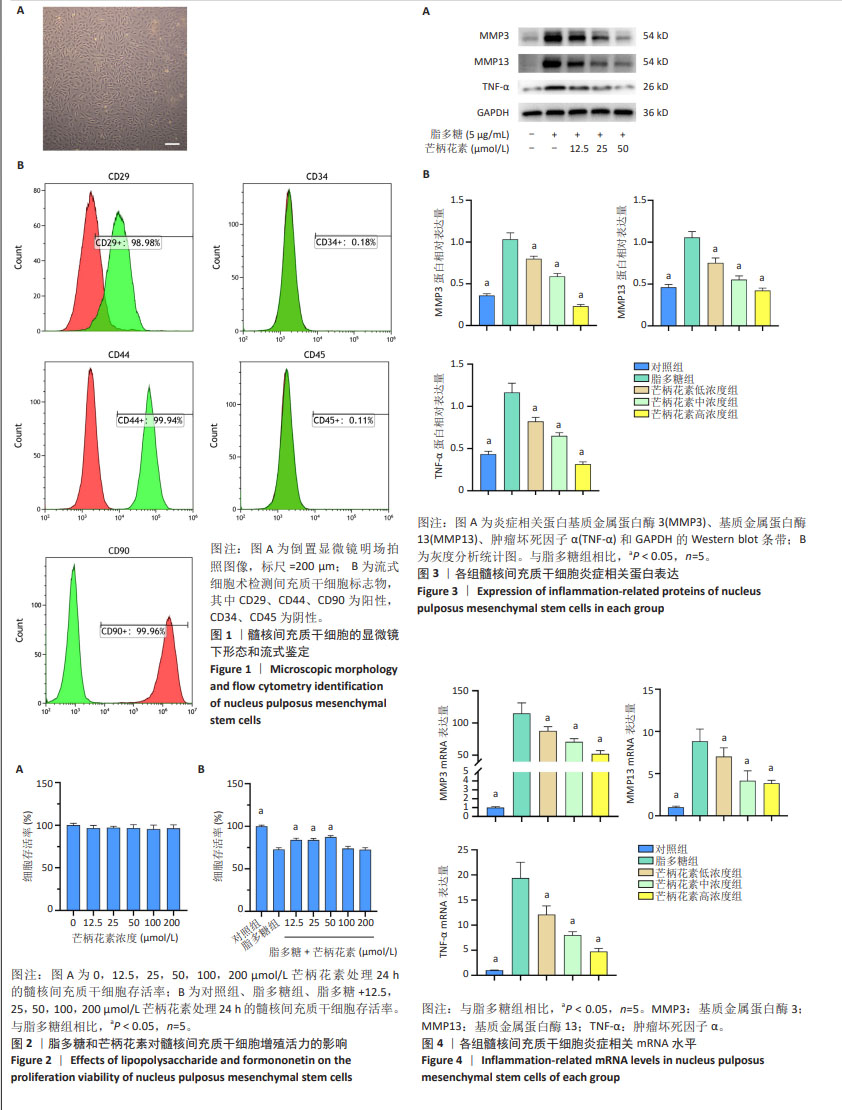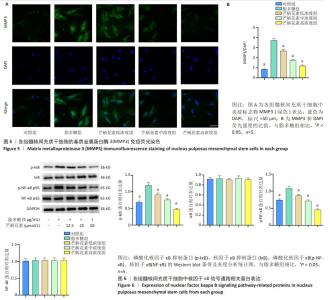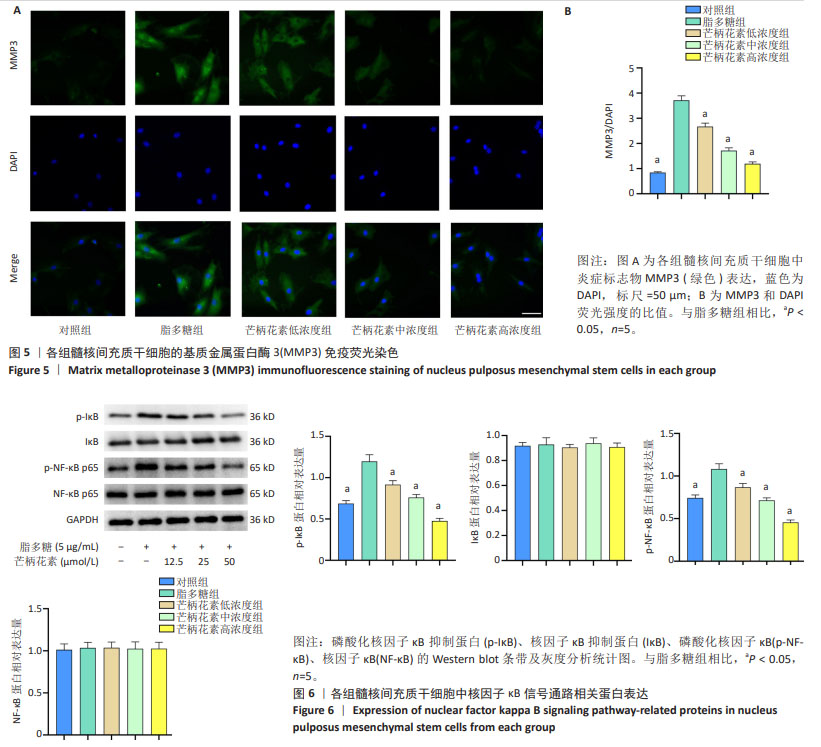[1] DAI J, LIU J, SHEN Y, et al. Regulation of endoplasmic reticulum stress on autophagy and apoptosis of nucleus pulposus cells in intervertebral disc degeneration and its related mechanisms. PeerJ. 2024;12:e17212.
[2] NOTARANGELO MP, PENOLAZZI L, LAMBERTINI E, et al. The NFATc1/P2X7 receptor relationship in human intervertebral disc cells. Front Cell Dev Biol. 2024;12:1368318.
[3] LI L, ZHANG G, YANG Z, et al. Stress-Activated Protein Kinases in Intervertebral Disc Degeneration: Unraveling the Impact of JNK and p38 MAPK. Biomolecules. 2024;14(4):393.
[4] HU Y, YANG R, LIU S, et al. The Emerging Roles of Nanocarrier Drug Delivery System in Treatment of Intervertebral Disc Degeneration-Current Knowledge, Hot Spots, Challenges and Future Perspectives. Drug Des Devel Ther. 2024;18:1007-1022.
[5] XIANG Z, ZHANG P, JIA C, et al. Piezo1 channel exaggerates ferroptosis of nucleus pulposus cells by mediating mechanical stress-induced iron influx. Bone Res. 2024;12(1):20.
[6] ZHOU L, CAI F, ZHU H, et al. Immune-defensive microspheres promote regeneration of the nucleus pulposus by targeted entrapment of the inflammatory cascade during intervertebral disc degeneration. Bioact Mater. 2024;37:132-152.
[7] 王冲,孔丽,崔学超,等.苦参碱对椎间盘退变大鼠髓核细胞凋亡的影响[J].中国组织工程研究,2024,28(27):4281-4287.
[8] HUANG G, SHEN H, XU K, et al. Single-Cell Microgel Encapsulation Improves the Therapeutic Efficacy of Mesenchymal Stem Cells in Treating Intervertebral Disc Degeneration via Inhibiting Pyroptosis. Research (Wash D C). 2024;7:0311.
[9] HUANG ZN, WANG J, WANG ZY, et al. SR9009 attenuates inflammation-related NPMSC pyroptosis and IVDD through NR1D1/NLRP3/IL-1β pathway. iScience. 2024;27(5):109733.
[10] HUANG ZN, WANG ZY, CHENG XF, et al. Melatonin alleviates oxidative stress-induced injury to nucleus pulposus-derived mesenchymal stem cells through activating PI3K/Akt pathway. J Orthop Translat. 2023;43:66-84.
[11] QIAN L, XU H, YUAN R, et al. Formononetin ameliorates isoproterenol induced cardiac fibrosis through improving mitochondrial dysfunction. Biomed Pharmacother. 2024;170:116000.
[12] YANG YZ, WANG T, CHEN QL, et al. Identification of the Metabolites of Both Formononetin in Rat Hepatic S9 and Ononin in Rat Urine Samples and Preliminary Network Pharmacology Evaluation of Their Main Metabolites. Molecules. 2023;28(21):7451.
[13] LAN H, QIU W, WU J, et al. Formononetin reverses Treg/Th17 imbalance in immune-mediated bone marrow failure mice by regulating the PI3K/Akt signaling pathway. Chin Med. 2024;19(1):55.
[14] ZHANG L, WU Q, HUANG Y, et al. Formononetin ameliorates airway inflammation by suppressing ESR1/NLRP3/Caspase-1 signaling in asthma. Biomed Pharmacother. 2023;168:115799.
[15] XIANG K, SHEN P, GAO Z, et al. Formononetin Protects LPS-Induced Mastitis Through Suppressing Inflammation and Enhancing Blood-Milk Barrier Integrity via AhR-Induced Src Inactivation. Front Immunol. 2022;13:814319.
[16] ZHOU Z, ZHANG P. Formononetin ameliorates the LPS-induced inflammatory response and apoptosis of neuronal cells via NF-κB/NLRP3 signaling pathway. Funct Integr Genomics. 2023;23(4):321.
[17] ZHU B, NI Y, GONG Y, et al. Formononetin ameliorates ferroptosis-associated fibrosis in renal tubular epithelial cells and in mice with chronic kidney disease by suppressing the Smad3/ATF3/SLC7A11 signaling. Life Sci. 2023;315:121331.
[18] PIZZICANNELLA J, FONTICOLI L, GUARNIERI S, et al. Antioxidant Ascorbic Acid Modulates NLRP3 Inflammasome in LPS-G Treated Oral Stem Cells through NFκB/Caspase-1/IL-1β Pathway. Antioxidants (Basel). 2021;10(5):797.
[19] XIA Q, ZHAO Y, DONG H, et al. Progress in the study of molecular mechanisms of intervertebral disc degeneration. Biomed Pharmacother. 2024;174:116593.
[20] MAVROGONATOU E, KLETSAS D. Plant-Derived Senotherapeutics for the Prevention and Treatment of Intervertebral Disc Degeneration and Aging. Metabolites. 2024;14(3):146.
[21] ROMANIYANTO, MAHYUDIN F, SIGIT PRAKOESWA CR, et al. An update of current therapeutic approach for Intervertebral Disc Degeneration: A review article. Ann Med Surg (Lond). 2022;77:103619.
[22] LEE S, KIM JG, KIM HJ. Comparison of surgical outcomes between lumbar interbody fusions using expandable and static cages: a systematic review and meta-analysis. Spine J. 2023;23(11):1593-1601.
[23] SONG C, HU P, PENG R, et al. Bioenergetic dysfunction in the pathogenesis of intervertebral disc degeneration. Pharmacol Res. 2024;202:107119.
[24] FU Q, GAO Q, JIAO S, et al. Adipose-derived stem cells ameliorate radiation-induced lung injury by activating the DDAH1/ADMA/eNOS signaling pathway. Regen Ther. 2024;27:398-407.
[25] 鄂正康,辛红伟,于清波,等.miR-192-5p 靶向 CKIP-1 促进骨质疏松患者骨髓间充质干细胞成骨分化[J].中国组织工程研究,2025, 29(13):2641-2647.
[26] OU X, YING J, BAI X, et al. Activation of SIRT1 promotes cartilage differentiation and reduces apoptosis of nucleus pulposus mesenchymal stem cells via the MCP1/CCR2 axis in subjects with intervertebral disc degeneration. Int J Mol Med. 2020;46(3):1074-1084.
[27] LIU Y, GAO GM, YANG KY, et al. Construction of tissue-engineered nucleus pulposus by stimulation with periodic mechanical stress and BMP-2. iScience. 2022;25(6):104405.
[28] WANG X, ZENG Q, GE Q, et al. Protective effects of Shensuitongzhi formula on intervertebral disc degeneration via downregulation of NF-κB signaling pathway and inflammatory response. J Orthop Surg Res. 2024;19(1):80.
[29] YANG J, SHA X, WU D, et al. Formononetin alleviates acute pancreatitis by reducing oxidative stress and modulating intestinal barrier. Chin Med. 2023;18(1):78.
[30] AGEEVA T, RIZVANOV A, MUKHAMEDSHINA Y. NF-κB and JAK/STAT Signaling Pathways as Crucial Regulators of Neuroinflammation and Astrocyte Modulation in Spinal Cord Injury. Cells. 2024;13(7):581.
[31] YAN B, YU X, CAI X, et al. A Review: The Significance of Toll-Like Receptors 2 and 4, and NF-κB Signaling in Endothelial Cells during Atherosclerosis. Front Biosci (Landmark Ed). 2024;29(4):161.
[32] YU L, HAO YJ, REN ZN, et al. Ginsenoside Rg1 relieves rat intervertebral disc degeneration and inhibits IL-1β-induced nucleus pulposus cell apoptosis and inflammation via NF-κB signaling pathway. In Vitro Cell Dev Biol Anim. 2024;60(3):287-299.
[33] KUPPA SS, KANG JY, YANG HY, et al. Hyaluronic Acid Viscosupplement Modulates Inflammatory Mediators in Chondrocyte and Macrophage Coculture via MAPK and NF-κB Signaling Pathways. ACS Omega. 2024; 9(19):21467-21483.
[34] HAN NR, PARK HJ, KO SG, et al. The Protective Effect of a Functional Food Consisting of Astragalus membranaceus, Trichosanthes kirilowii, and Angelica gigas or Its Active Component Formononetin against Inflammatory Skin Disorders through Suppression of TSLP via MDM2/HIF1α Signaling Pathways. Foods. 2023;12(2):276. |



